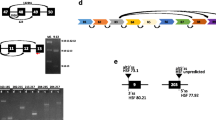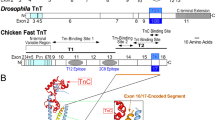Abstract
(1) Molecular variations in two turkey skeletal muscle ryanodine receptor gene isoforms, αRYR and βRYR, were analyzed by cloning and sequencing the entire cDNAs of the two isoforms. (2) Ten alternative splicing transcript variants (ASTVs) in the αRYR isoform were identified. These variants were clustered in three alternative splicing regions (ASRs). Two ASRs overlap with the divergent regions (DRs) of the two isoforms. Only four ASTVs did not contain a frame shift and potentially can be translated into αRYR channel proteins. The expression of these three ASTVs was developmentally or environmentally regulated. (3) Ten SNPs and eight haplotypes, divergent in the ten SNP positions, were identified in βRYR. Although the ten SNPs were synonymous, different mRNA secondary structures of βRYR and different stability of the structures were predicted for several SNPs. (4) The intriguing finding of this study is that αRYR and βRYR use completely divergent mechanisms to generate molecular variations. Alternative splicing generates ASTVs of αRYR, whereas the presence of SNPs may change the secondary mRNA structure of βRYR. These divergent mechanisms could affect calcium channel activity of either or both RYR isoforms.






Similar content being viewed by others
References
Airey JA, Baring MD, Beck CF, Chelliah Y, Deerinkc TJ, Ellisman MH, Houenou LJ, McKemy DD, Sutko JL, Talvenheimo J (1993) Failure to make normal alpha ryanodine receptor is an early event associated with the crooked neck dwarf (cn) mutation in chicken. Dev Dyn 197:169–188
Baker ML, Serysheva II, Sencer S, Wu Y, Ludtke SJ, Jiang W, Hamilton SL, Chiu W. (2002) The skeletal muscle Ca2+ release channel has an oxidoreductase-like domain. Proc Natl Acad Sci 99:12155–12160
Capon F, Allen MH, Ameen M, Burden AD, Tillman D, Barker JN, Trembath RC (2004) A synonymous SNP of the corneodesmosin gene leads to increased mRNA stability and demonstrates association with psoriasis across diverse ethnic groups. Hum Mol Genet 13:2361–2368
Chang Y-F, Imam JS, Wilkinson MF (2007) The nonsense-mediated decay RNA surveillance pathway. Annu Rev Biochem 76:51–74
Chiang W, Allison CP, Linz JE, Strasburg GM (2004) Identification of two αRYR alleles and characterization of αRYR transcript variants in turkey skeletal muscle. Gene 330:177–184
Chiang W, Byrem T, Zhang H, Strasburg GM (2007) Binding property of avian skeletal muscle ryanodine receptor isoforms with dihydropyridine receptor and calmodulin. J Muscle Res Cell Motil 28:59–66
Du GG, Khanna VK, MacLennan DH (2000) Mutation of divergent region 1 alters caffeine and Ca2+ sensitivity of the skeletal muscle Ca2+ release channel (ryanodine receptor). J Biol Chem 275:11778–11783
Duan J, Wainwright MS, Comeron JM, Saitou N, Sanders AR, Gelernter J, Gejman PV (2003) Synonymous mutations in the human dopamine receptor D2 (DRD2) affect mRNA stability and synthesis of the receptor. Hum Mol Genet 12:205–216
Falquet L, Pagni M, Bucher P, Hulo N, Sigrist CJ, Hofmann K, Bairoch A (2002) The PROSITE database, its status in 2002. Nucleic Acids Res 30:235–238
Fujii J, Ostu K, Zorzato F, Leon SD, Khama VK, Weiler JE, O’Brien PJ, MacLennan DH (1991) Identification of mutation in porcine ryanodine receptor associated with malignant hyperthermia. Science 253:448–451
Futatsugi A, Kuwajima G, Mikoshiba K (1995) Tissue-specific and developmentally regulated alternative splicing in mouse skeletal ryanodine receptor mRNA. Biochem J 305:373–378
George CH, Jundi H, Thomas NL, Fry DL, Lai FA (2007a) Ryanodine receptors and ventricular arrhythmias: emerging trends in mutations, mechanism and therapies. J Mol Cell Cardiol 42:34–50
George CH, Rogers SA, Bertrand BM, Tunwell RE, Thomas NL, Steele DS, Cox EV, Pepper C, Hazeel CJ, Claycomb WC, Lai FA (2007b) Alternative splicing of ryanodine receptors modulates cardiomyocyte Ca2+ signaling and susceptibility to apoptosis. Circ Res 100:874–883
Hamilton SL (2005) Ryanodine receptors. Cell Calcium 38:253–260
Ivanenko A, McKemy DD, Kenyon JL, Airey JA, Sutko JL (1995) Embryonic chicken skeletal muscle cells fail to develop normal excitation-contraction coupling in the absence of the alpha ryanodine receptor. Implications for a two-ryanodine receptor system. J Biol Chem 270:4220–4223
Jackson IJ (1991) A reappraisal of non-consensus mRNA splice sites. Nucleic Acids Res 19:3795–3798
Jiang D, Xiao B, Li X, Chen SRW (2003) Smooth muscle tissues express a major dominant negative splice variant of the type 3 Ca2+ release channel (ryanodine receptor). J Biol Chem 278:4763–4769
Kennedy C, Berget SM (1997) Pyrimidine tracts between the 5′ splice site and branch point facilitate splicing and recognition of a small Drosophila intron. Mol Cell Biol 17:2774–2780
Kimura T, Nakamori M, Lueck JD, Pouliquin P, Aoike F, Fujimura H, Dirksen RT, Takahashi MP, Dulhunty AF, Sakoda S (2005) Altered mRNA splicing of the skeletal muscle ryanodine receptor and sarcoplasmic/endoplasmic reticulum Ca2+-ATPase in myotonic dystrophy type 1. Hum Mol Genet 14:2189–2200
Krogh A, Larsson B, von Heijne G, Sonnhammer ELL (2001) Predicting transmembrane protein topology with a hidden Markov model: application to complete genomes. J Mol Biol 305:567–580
Marziali G, Rossi D, Giannini G, Charlesworth A, Sorrentino V (1996) cDNA cloning reveals a tissue specific expression of alternative spliced transcripts of the ryanodine receptor type 3 (RyR3) calcium release channel. FEBS Lett 394:76–82
Miyatake R, Furukawa A, Matsushita M, Iwahashi K, Nakamura K, Ichikawa Y, Suwaki H (1996) Tissue-specific alternative splicing of mouse brain type ryanodine receptor/calcium release channel mRNA. FEBS Lett 395:123–126
Murayama T, Ogawa Y (2001) Selectively suppressed Ca2+-induced Ca2+ release activity of α-ryanodine receptor (α-RyR) in frog skeletal muscle sarcoplasmic reticulum. J Biol Chem 276:2953–2960
Murayama T, Ogawa Y (2002) Roles of two ryanodine receptor isoforms coexisting in skeletal muscle. Trends Cardiovasc Med 12:305–311
Murayama T, Ogawa Y (2004) RyR1 exhibits lower gain of CICR activity than RyR3 in the SR: evidence for selective stabilization of RyR1 channel. Am J Physiol Cell Physiol 287:36–45
Nackley AG, Shabalina SA, Tchivileva IE, Satterfield K, Korchynskyi O, Makarov SS, Maixner W, Diatchenko L (2006) Human catechol-O-methyltransferase haplotypes modulate protein expression by altering mRNA secondary structure. Science 314:1930–1933
Ottini L, Marziali G, Conti A, Charlesworth A, Sorrentino V (1996) α and β isoforms of ryanodine receptor from chicken skeletal muscle are homologous of mammalian RyR1 and RyR3. Biochem J 315:207–216
Pietrzak M, Greaser ML, Sosnicki AA (1997) Effect of rapid rigor mortis processes on protein functionality in pectoralis major muscle of domestic turkeys. J Anim Sci 75:2106–2116
Robinson R, Carpenter D, Shaw M-A, Halsall J, Hopkins P (2006) Mutations in RYR1 in malignant hyperthermia and central core disease. Hum Mutat 27:977–989
Roseman MA (1988) Hydrophilicity of polar amino acid side chains is markedly reduced by flanking peptide bonds. J Mol Biol 200:513–522
Senapathy P, Shapiro MB, Harris NL (1990) Splice junctions, branch point sites, and exons: sequence statistics, identification, and applications to genome project. Methods Enzymol 183:252–278
Sorrentino V, Volpe P (1993) Ryanodine receptors: how many, where and why? Trends Pharmacol Sci 14:98–103
Takechi H, Hosokawa N, Hirayoshi K, Nagata K (1994) Alternative 5′ splicing site selection induced by heat shock. Mol Cell Biol 14:567–575
Tosso L, Brenig B (1998) cDNA cloning and sequencing of the human ryanodine receptor type 3 (RYR3) reveals a novel alternative splice site in the RYR3 gene. FEBS Lett 423:367–370
Tusnády GE, Simon I (1998) The HMMTOP transmembrane topology prediction server. Bioinformatics 17:849–850
Yost HJ, Lindquist S (1986) RNA splicing is interrupted by heat shock and is rescued by heat shock protein synthesis. Cell 45:185–193
Zalk R, Lehnart SE, Marks AR (2007) Modulation of the ryanodine receptor and intracellular calcium. Annu Rev Biochem 76:367–385
Zhao M, Li P, Li X, Zhang L, Winkfein RJ, Chen SRW (1999) Molecular identification of the ryanodine receptor pore-forming segment. J Biol Chem 274:25971–25974
Zuker M, Mathews DH, Turner DH (1999) Algorithms and thermodynamics for RNA secondary structure prediction: a practical guide. In: Barciszewski J, Clark BFC (eds) RNA biochemistry and biotechnology. Kluwer Academic Publishers, New York, pp 11–43
Acknowledgments
This research was supported by USDA-National Research Initiative Grant 2001-01581, by the Michigan State University Animal Agriculture Coalition, and the Michigan Agriculture Experiment Station. The authors are grateful to Dr. Sandra Velleman for the donation of turkey breast muscle from 18-day embryo, 1-day post hatch poult, and 16-week post hatch turkey.
Author information
Authors and Affiliations
Corresponding author
Rights and permissions
About this article
Cite this article
Chiang, W., Yoon, HJ., Linz, J.E. et al. Divergent mechanisms in generating molecular variations of αRYR and βRYR in turkey skeletal muscle. J Muscle Res Cell Motil 28, 343–354 (2007). https://doi.org/10.1007/s10974-008-9130-4
Received:
Accepted:
Published:
Issue Date:
DOI: https://doi.org/10.1007/s10974-008-9130-4




